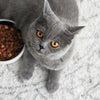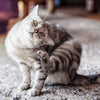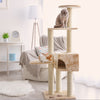Can Cat Litter Be Flushed?
- by Rufus and Coco
The cat product industry has come a long way since the 1940s when one pet parent came up with the idea of using sand as litter for their feline friends. Another material that was used for cat waste was Fuller’s Earth, a clay-like substance that contains aluminium magnesium silicate.
These days, most of the litters you will come across if you’re looking to change the one you've been using are the flushable ones.
But are they safe? What litter types are out there and which ones are safe to flush down the toilet? We’re answering all of these questions and more in today’s post, so keep on reading.
Is Cat Litter Safe to Flush?
The short answer to this question is that it depends on the type you get. Some products, such as our own Wee Kitty Clumping Corn litter or the Do Good Cat Litter, can make a pet parent’s life easier as they can be flushed down the toilet.
Other types aren’t as safe and they run the risk of not just adding microorganisms to your local waterways, but they might also create a clog.
What types of litter should you never flush?
Clay-based litters are, by far, the most dangerous ones to flush and that’s because they are made to absorb moisture as much as possible. For the same reason, they can expand their size by up to 15 times.
Therefore, if you also flush down some unused litter along with the ones that have absorbed cat urine, you might create a serious issue with your plumbing. Do not flush clay-based litter into the local waste system no matter how much you might want to.
Moreover, clay-based litters are also messy and could present a risk to your cat’s health. They create a lot of dust which could get into a cat’s respiratory system and the mildest health problem that he or she could develop is rhinitis.
Although it is perhaps the cheapest option when it comes to cat litter, a clay-based one is almost always the worst choice in every way, especially when it comes to their environmental impact.
Besides this type, others that you cannot dispose of in such a way are pine litters and silica gel litters.
What types of litter can you flush?
You can flush down the toilet any litter that’s made of corn, wheat, tofu, shredded paper, or wood remains. Some pine varieties are not flushable, however.
The best way of knowing whether you are allowed to flush your cat litter is to make sure that you read the label. Many brands are marketed as flushable, but they could contain some ingredients that might make them less so. Make sure that the litter is completely made of grains or tofu, such as our own Wee Kitty Eco Plant Clumping Litter.
Is flushable cat litter better?
There are two main reasons why flushable cat litter beats all the rest. First of all, it’s the easiest to dispose of.
Some pet parents might choose to simply dispose of the solid waste or the clumps by flushing them down the toilet and throwing away the rest with their regular trash. This is another option that you can use, of course.
One note that we have to make with regard to any type of flushable cat litter is that it can create clogs if you flush too much of it at once. If you add a whole pound of litter to your toilet bowl and then flush, the likelihood of it creating an issue with your plumbing can be higher, especially if the pipes are already partially clogged.
The second reason why flushable cat litter has become so popular in the past several years is that most of the varieties you will come across are ecologically sustainable. Clay-based cat litter, for instance, needs to be strip-mined, which is detrimental to the environment.
Flushable litter varieties are made of biodegradable materials such as wood, grains, or paper. Many of these ingredients actually come from renewable sources, which means that these litter brands do not have a negative impact on our planet in any way.
Conclusion
Not all cat litter can be flushed and in order to avoid clogging your toilet or smaller plumbing, you should stick to the manufacturer’s advice every time. If the litter is clearly not marketed as flushable, you can dispose of it in another eco-friendly way.
Do not mix cat litter that’s been obviously soiled with cat waste with your compost as you might spread dangerous parasites, especially if you intend to use your compost on the plants you grow and want to eat.
The greenest way of disposing of litter is by first removing the urine and feces clumps into a biodegradable bag and adding it to your trash, and only then composting whatever unsoiled remains are left.
Ideally, cat waste should never be used for composting, especially if it could come into contact with drinking water. If cat feces end up in water that people drink or if the feces are used as compost for growing vegetables, you could risk contracting Toxoplasmosis, a disease that many cats across the globe carry.
- Posted in:
- cat
- cat litter
- cats
- litter
- weekitty








